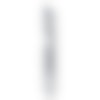Designing the Task Knife
Recently, our lead designer Sean Kelly sat down with team member Sara Segura to discuss the inspiration for the task knife, pivots and tradeoffs in the process, and everything else that went on behind the scenes to design the task knife and stand. Enjoy!
We set out to design a cutting tool for your desk—not a tactical fixed blade that can cut through anything, but something that would look elegant on display while being an effective tool for opening boxes, and other light duty desk tasks. This product is all about tradeoffs, balancing function with aesthetics.

Hello!

Tell me about the inspiration for the task knife.

We've always been interested in the desk. We've made the big stuff, the things that hold your monitors and laptops and all your other stuff. We wanted to start creating things that were smaller, more handheld.

When you designed the measure collection, you took inspiration from some products in the everyday carry collection, but you moved those into a desk-oriented design. Is inspiration still coming from the everyday carry in this product in a major way, especially from the minimalist knife?

Both the minimalist knife and everything in the metal area of everyday carry. As we were exploring the task knife we decided, I'd say halfway through the process, to just use the exact same blade profile.

The minimalist knife, in black, brass, and titanium.

Early on, too, we were looking at the key ring to inspire a specific type of machining, and one big thing was the machined bevel. Because the task knife is a single machined piece—blade and handle—we were able to control that angle and shape.


What makes this stand apart from the everyday carry knife as a uniquely desk-oriented product?

The fact that it's clip-less, as well as it being fixed blade. There's no sheath involved. Instead of doing a sheath, (which would put it into the carry realm, where you'd put it in your bag or put it in your pocket), we designed a stand for it. We didn't want to have an exposed blade all the time just laying around on your desk. Giving it a stand gives it a home, a place where you always know it will be there, so you can grab it when you need to make a cut.

Initial explorations of edge treatment

At what point in the design process did you really start to get excited about the task knife?

I think I was pretty excited from the beginning, but looking into different types of knives again was really fun. We explored the different cutting edge positions to figure out the best position that we could place the cutting edge for what we wanted the knife to do—open boxes, letters, and make small cuts.

Initially, we were thinking about doing a chisel tip where the cutting edge was on the tip, but through some ergonomic studies and actually trying out some different things, we quickly came to realize that it should be on the long side of the knife.

Tell me about the task knife's sculptural aesthetic. What was your process for dialing in those details to get the balance just right?

Early on, the knives were looking like combs kind of, or almost like if you took a razor blade, and just had that by itself. Then we started to separate blade from handle, while still having it be one piece. Where the handle hits your hand, it needs to be soft in order to feel good, because we wanted to make the handle short. Having this rounded end hit your palm was really important. But the big detail is just that scoop of the blade; the bevel coming down and disappearing, and then carrying on that diameter into the end.

Studies of task knife blade shape and detail.

And didn't you machine a variety of different ratios of blade length to handle length?

Originally, it was just a straight edge. So you're machining and there's nothing here, but that makes it hard to sharpen. So you create the separation for sharpening, but that separation, that choil almost has this rainbow effect. The shapes keep bouncing off of each other and lines are parallel to one another, which I really like. I think the choil on this knife kind of makes the knife.


This product is bold in that it's designed around a single function.

We always wanted to create a second knife, and with the success of our desk collection, the application was just a no-brainer for us to create something for the desk specifically. I think the pen drove that a lot. Doing the pen and then being like, okay, let's make another small desk item, and the knife just made sense.


And how did the success of the pen's stand influence this? That was kind of surprising, wasn't it?

It was really surprising—because the stand did such a good job, it allowed us to do a double grind on both sides of the knife instead of doing a single grind, and then creating a nice, beautiful stand where it could sit and safely be stored.

That actually leads me to one of the main intentions of the desk collection—the idea of having a place for everything. Was that running through your head as you designed this product? Especially since it could easily be something that floats aimlessly around a desk?

Totally, yeah. I was concerned about throwing a knife like this into like a drawer, for instance. I mean, everyone does it at home in their kitchen, right? We created a version of a knife storage solution for an office, as opposed to a kitchen area or EDC. It's easy to grab from, and it also holds it up in a sculptural way. We explored a lot of different options with the stand and we tried some things that were a bit more pricey, like directly riffing off of the pen stand specifically. But the value proposition didn't quite align with what the knife was doing. So we created something really simple that was more inspired by our trays and things that we already have on the desk. Visually, you'll be able to reach and see where you want to put your fingers on the handle of the blade and then pop it out so that you can make your quick cut and then pop it back in.

Is this the first time that we've specifically machined that smooth scoop?

We traditionally do chamfers, but with this product, the chamfer was kind of lost because it was so subtle. So we went with a scoop to better define the shape so that it was more visually apparent. It's something we haven't done before except on the headphone stand.

So with the task knife fully designed, ready for customers, what remains your favorite thing about it?

I think the grip. getting my fingers onto this bevel, this little rounded area right above the choil. I just love that feeling and the idea of actually utilizing the bevel of the knife in that way is really cool.

I've always been personally inspired by Japanese design, and I know Ken (Tomita, CEO / Co-Founder) is, too. Our original knife was inspired by the higonokami, and we looked into kiridashi knives a lot in the design of this one. We were inspired by the simplicity of those knives: a knife that's just made from one piece of metal. It's just so beautiful and so specific.


It's challenging in a way but it removes a lot of variables.

Knives don't need a lot to work. They just need a sharp edge and a place to hold them, and I think this knife is the embodiment of that idea.

And there's so many options out there with the idea of just a blade and something to hold on to. There are so many places you could go with it.

This is just something that you can use all the time. You'll take care of it, it'll take care of you: you don't have to refill it; it's not garish; it doesn't have bright colors or anything like that. It's just simple. A single material, and a stand.

It helps you complete a task you can’t do with your own fingers.

Yup. I've tried. It's the worst.

So much tape has gotten the better of me.

Yeah, or I've tried to like rip open a box and I just, "Agh, I can't!" The tape just won't budge.

And all you need is a single little sharp thing to just slice it.

I was never picturing our second knife being a desk knife. We followed in the progression of Grovemade as a company, and created something very specific for the desk.

So it really fits into the Grovemade brand and story.

And it makes me wonder what else could we make for the desk in this realm. The smaller, more handheld tool category.

It's exciting!
Works Alone
Let the machining shine in raw brass or stainless steel, or go for the matte look with a black ceramic coating.



















